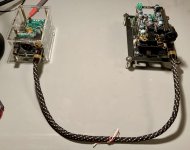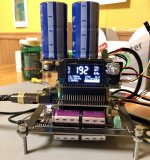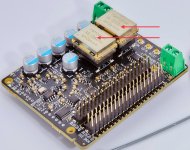Thanks. Will try it tomorrowDo You have monitorpipro? Try "16 to 32 bit enabled"...
But I am wonder why the dac can’t output the true 16/44.1?
I have used another hdmi hat without this issue.
Hmm... one of my dac's refuses to play CD (16b/44.1) from old Kenwood cd transport (with 16.344MHz clock) but it plays 16b/44.1 from Shanling ET3 but only with 1024Fs option ... and it plays cd via bluray player... why ? (it doesn't matter if signal is directly from cd tr. Toslink or coax spdif or i2s via fifopi or i2s from et3)Thanks. Will try it tomorrow
But I am wonder why the dac can’t output the true 16/44.1?
I have used another hdmi hat without this issue.
Thank you shoom
100% the best PSU by far is the UcPure and you see I have them there which is just powering the balanced output module
Thanks for the info Simon and something for the future. In Xmas wrapping paper maybe.😎
My first time with batteries and big caps and I'm pretty impressed so far.
Nice build and interesting concept.Here is my setup with optical cable for galvanic separation from RPi4. I will put them in two separate boxes. I have listened a bit and it sounds very good
Is that a PI2AES you have driving the Ian stuff?
I asume you are talking about the SC Pure clocks.Does anyone have the type / spec of the new Q7 ll clocks
https://www.diyaudio.com/community/...eapon-to-fight-the-jitter.192465/post-7433057
Otherwise, the original clocks on Q7 are Accusillicon A318.
Last edited:
Today I assembly the stationpi but It don’t send I2s signal to fifopi. All gpio is good in continuity test.
Fifopi can lock I2s when stacked installation with pi.
Is it necessary to solder the stationpi earth pin to Fifopi ground?
Fifopi can lock I2s when stacked installation with pi.
Is it necessary to solder the stationpi earth pin to Fifopi ground?
Yes 👍 5volt. Version 2Nice build and interesting concept.
Is that a PI2AES you have driving the Ian stuff?
Last edited:
I have a vague recollection of Ian mentioning those clocks being SC cuts but not the same type as the Pure.Does anyone have the type / spec of the new Q7 ll clocks
He said they where better than Accusilicon.
''Yes 👍 5volt. Version 2''
Nice
I had eyes one of those but ended up with a Digione sig.
Wish I'd gone with the more versatile PI2AES.
Nice
I had eyes one of those but ended up with a Digione sig.
Wish I'd gone with the more versatile PI2AES.
just remembered the post from Ian re the Q7 clocks.
''FemtoMck could be one of the best audio clock made from AT-cut crystals. There is no need for FifoPiQ7II to change to any other AT-cut XOs unless upgrading to the SC-Pure clocks.
SC-Pure clocks are made from SC-cut crystal. SC-Pure clocks are at the higher grade.''
''FemtoMck could be one of the best audio clock made from AT-cut crystals. There is no need for FifoPiQ7II to change to any other AT-cut XOs unless upgrading to the SC-Pure clocks.
SC-Pure clocks are made from SC-cut crystal. SC-Pure clocks are at the higher grade.''
I bought a couple of board late December last year, including the FIFOPI Q7 and HDMIPI Pro which of course got an upgrade not a month later because story of my live, and also the PurePI II.
The PurePI II was to get started and see how things worked, etc.
But now I want to move further and I have a question.
How much better is a UCConditioner MkII with LinearPi MkII than the PurePI II with LinearPi MkII?
My idea is to go with a StationPI Pro and either dual UCConditioner MkII (one 5V and one 3.3V) with LinearPi MkII Dual for the Raspberry Pi and FIFOPI Q7+HDMIPI Pro, or use the PurePI II for the Raspberry PI and a UCConditioner MkII with LinearPi for the boards. Or vice versa depending on which is better.
On the other hand, the HDMIPI Pro can be supplied with it's own 3.3V clean power, so maybe dual UCConditioner MkII (one 5V and one 3.3V) with LinearPi MkII and the PurePI II.
It's feels like a shame not to use the LurePI II anymore, so I am really unsure what would be the best route to follow here.
Hopefully someone can give me insights in this.
The PurePI II was to get started and see how things worked, etc.
But now I want to move further and I have a question.
How much better is a UCConditioner MkII with LinearPi MkII than the PurePI II with LinearPi MkII?
My idea is to go with a StationPI Pro and either dual UCConditioner MkII (one 5V and one 3.3V) with LinearPi MkII Dual for the Raspberry Pi and FIFOPI Q7+HDMIPI Pro, or use the PurePI II for the Raspberry PI and a UCConditioner MkII with LinearPi for the boards. Or vice versa depending on which is better.
On the other hand, the HDMIPI Pro can be supplied with it's own 3.3V clean power, so maybe dual UCConditioner MkII (one 5V and one 3.3V) with LinearPi MkII and the PurePI II.
It's feels like a shame not to use the LurePI II anymore, so I am really unsure what would be the best route to follow here.
Hopefully someone can give me insights in this.
Hello,Here is my setup with optical cable for galvanic separation from RPi4. I will put them in two separate boxes. I have listened a bit and it sounds very good
I think we are starting to reach a consensus if you are serious about using the Raspberry you better spend money on the physical and electric ( galvanic) separation of this noise emitter .
Ian told us somewhere you will need a board on the Raspberry and a board on Fifopi side to get them interconnected by hdmi( here done by optical cable) . If you this the Raspberry can be fed by a standard supply.
I think this will not be that much more expensive and if you can put the Raspberry at a safe ( one meter?) distance from sensitive gear it would be a big plus.
Will order at Audiophonics when i am back in Europe. Easier to get support there because i am in the same time zone.
Waiting for some suggestions how to execute things. Maybe the optical cable solution can be tested if there is a minimum distance needed to get maximum separation? It could well be that a 90 degree turn could be beneficial? Or does it emit garbage all around?
Greetings Eduard
....yes I plan to experiment with moving the Pi.
I decided to build the easy system first to get some music and then make the changes to see what differences there are in sound (if at all).
I do feel at times we go too far and the effort needed is not worth it for the perceived sound improvements, its all about the music right?
I decided to build the easy system first to get some music and then make the changes to see what differences there are in sound (if at all).
I do feel at times we go too far and the effort needed is not worth it for the perceived sound improvements, its all about the music right?
Hello,
I think we are starting to reach a consensus if you are serious about using the Raspberry you better spend money on the physical and electric ( galvanic) separation of this noise emitter .
Ian told us somewhere you will need a board on the Raspberry and a board on Fifopi side to get them interconnected by hdmi( here done by optical cable) . If you this the Raspberry can be fed by a standard supply.
I think this will not be that much more expensive and if you can put the Raspberry at a safe ( one meter?) distance from sensitive gear it would be a big plus.
Will order at Audiophonics when i am back in Europe. Easier to get support there because i am in the same time zone.
Waiting for some suggestions how to execute things. Maybe the optical cable solution can be tested if there is a minimum distance needed to get maximum separation? It could well be that a 90 degree turn could be beneficial? Or does it emit garbage all around?
Greetings Eduard
I have ordered parts for HDMI use. and I will use it if it sounds better.
Attachments
- Home
- Source & Line
- Digital Line Level
- Asynchronous I2S FIFO project, an ultimate weapon to fight the jitter



